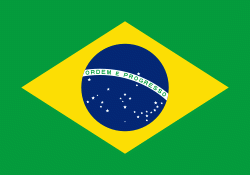Oliveira (Oliveira)
 |
 |
Oliveira is the birthplace of Brazilian scientist Carlos Chagas. A person from Oliveira can be called "Oliveirense".
Oliveira's history begins around the middle of the 16th century. Portuguese travellers used to stop in Oliveira's region, when travelling towards Goiás, through the "Picada de Goiás" or "Caminho de Goiás" (Path of Goiás). From this small village emerged the city. It used to have considerable political importance and regional hegemony during the Brazilian Empire.
Some stories say that a disease outbreak in the region of Mariana was also responsible for a great migration to Oliveira. The village of Oliveira used to belong to the village of São José do Rio das Mortes, which is the current Tiradentes (Minas Gerais), and it already possessed a chapel in 1758. The village was raised to the title of parish on July 14, 1832, and then raised to a town, on March 16, 1839, by the provincial law nº 134. Finally, it was lifted to the title of city on September 19, 1861. Differently than other cities in the same region, such as Ouro Preto and São João Del Rei, Oliveira did not emerge due to the exploration of gold and diamond, instead, the development of livestock and agriculture activities were the main reasons. Such activities began with the Bandeirantes that started to migrate from São Paulo to the countryside of Minas Gerais. During the transition from village to city, the municipality had always stood as a strategic place for goods exchange and capital flow, as it was an important path for travellers. Therefore, all these reasons were responsible for the rapidly growth of the municipality at that time. After the end of slavery in Brazil, the Brazilian government stimulated the immigration. Oliveira received Syrian and Lebanese settlers, who managed the commerce activities. Moreover, the city had a very strong Portuguese influence, mainly in architecture.
There are two versions about the origin of the Oliveira's name. There are stories that the first inhabitants of the region found some olive trees. Therefore, they named the place "Oliveiras" that later would be simplified to Oliveira. However, there is a rumor that a Portuguese woman, called Dona Maria de Oliveira, used to live in the region during the second half of the 18th century. She used to live in a house in the region where Oliveira currently exists, when the first Bandeirantes started to travel towards Goiás. Therefore, Oliveira was named because of her surname.
In the beginning of the 20th century, the city became around the world, as it was the birthplace of the famous scientist Carlos Chagas. He discovered the Chagas disease and he was the pioneer in the research of diseases caused by protozoa. He was also indicated to the Nobel Prize in the beginning of the 20th century in Germany.
Map - Oliveira (Oliveira)
Map
Country - Brazil
Currency / Language
| ISO | Currency | Symbol | Significant figures |
|---|---|---|---|
| BRL | Brazilian real | R$ | 2 |
| ISO | Language |
|---|---|
| EN | English language |
| FR | French language |
| PT | Portuguese language |
| ES | Spanish language |

















